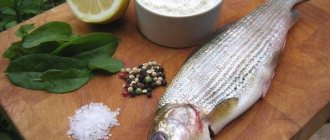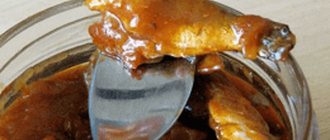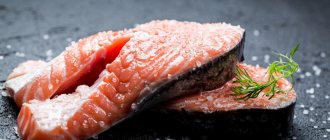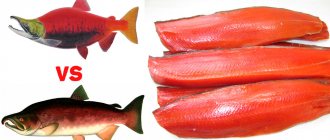Fresh fish and salt of the right caliber
Salting fish begins with a selection of quality products. We are primarily interested in salmon, pink salmon, chum salmon, herring, trout and mackerel. Haddock, pollock and halibut also work well. Of course, preference should be given only to the freshest chilled fish. When frozen, it has already lost all its valuable taste qualities.
It is best to take the whole fish. This makes it easier to determine freshness. Quality fish have clear eyes and bright red gills. No spots or yellowness on the flesh. It should be elastic and quickly restore its shape when pressed with a finger. There should be no foreign unpleasant odors. Cutting fish is quite simple. First, the head and fins are cut off. A long longitudinal incision is then made in the abdomen and the entrails are removed. Next, cut out the pulp and carefully separate it from the bones. If the fillet is small, you can salt it whole. It is more convenient to cut large fillets into portions.
Some housewives do not attach much importance to the choice of salt, and this is completely in vain. Only table rock salt is suitable for salting, but in no case iodized salt. Iodine has the property of burning the flesh of fish, causing it to become hopelessly spoiled. Choose coarse or medium-grained salt, as too fine crystals penetrate deeply into the flesh, thereby dehydrating it. As a result, your fish will be dry and tough.
What fish is suitable for salting?
Bream caught in the Kuban and Siberia look the same, but taste like two different types. Kuban - melts in your mouth. It is a dish in itself; the Siberian one is only suitable for beer. Predators on a “diet” of small salmon, on the contrary, only become tastier to the north.
There are several rules:
- carp fish species, tastier to the south;
- predators and salmonids gain a taste for the north.
There are exceptions to these rules. For example, crucian carp caught in Yakutia is tastier than ordinary crucian carp from the middle zone. Grayling, second in taste only to sturgeon, near Norilsk, according to stories, is completely tasteless.
Note! You can salt almost any fish found in reservoirs, as well as those sold frozen and fresh in markets and stores. Fish is divided by species as follows:
Marine
The main varieties: herring, herring, capelin, mackerel, mackerel, mullet, halibut, flounder.
Carp
Roach, roach, ram, crucian carp, carp, carp, bream, sabrefish, ide, bleak, fish.
Predatory species
Catfish, pike, pike perch, asp (carp fish), perch, bersch.
Salmonidae
The most delicious ones available: whitefish, char, grayling, trout, salmon, taimen, coho salmon, lenok, nelma, pink salmon.
Sturgeon
They are listed in the Red Book as endangered species. Prohibited from fishing. We will not consider them. Just in case, if you suddenly get a sturgeon, release it. The same is recommended for taimen.
If the fish is dead, but you decide to cook it, pull out the vizig (chord) near the vertebra. If this is not done, poisoning can lead to serious complications. Salting must be done at a very low temperature.
Important! Check your catch or purchase for parasites. Especially bought secondhand at the market. It won't take much time. One fish is enough. Gut it, look carefully at the giblets, then the inside of the fish.
Any thickenings that differ in color and look like a pea should alert you. Do the same by cutting the carcass into fillets. If in doubt, refuse to purchase. It should not be given to pets, but rather destroyed.
The right utensils and set of spices
Here are a few key subtleties that are important to follow, no matter what homemade fish salting recipe you choose. Do not use metal utensils for this, otherwise the fish will acquire an unpleasant characteristic metallic taste. Let it be a glass jar or ceramic container. High-quality food-grade plastic is also allowed.
Don't be afraid to make a mistake with the right amount of salt. Experienced housewives recommend following this proportion: for 1 kg of fish, take 3 tbsp. l. salt. Even if you take it in excess, nothing bad will happen. The fish will take exactly as much salt as it needs. You can easily remove any leftovers at the end of cooking. Don't forget to add sugar. It is this ingredient that will give the fish the desired softness and exquisite, pleasant notes. Sugar is taken half as much as salt.
Usually these two ingredients are enough for classic pickling. But you can always experiment with coriander, black and white pepper, cloves, cinnamon, bay leaves, nutmeg, ground ginger, dry herbs and any other spices.
Dry salting of large fish
This method is good for salting fish weighing more than 1 kg . Let's start preparing the product; for this you need to cut the carcasses from the back, remove the insides from them and cut out the gills. It is not necessary to wash the product; you just need to blot the fish with a paper towel. Sprinkle the inside generously with salt and place the product in a wooden box, the bottom of which is strewn with salt. We place each subsequent carcass head to tail of the previous one, sprinkle all layers with salt.
The salting process lasts for 5-7 days. The brine that is released during the salting process will flow out through the cracks in the box. This is the principle of our dry salting recipe; the fish in it is not oversaturated with moisture and is subsequently stored for a long time. Many fishermen use this method to store fish during fishing, but when traveling, they salt it not in a box, but in a mat (burlap). It is suspended over a dug hole, and the brine flows directly into the ground. This is also an ancient, time-tested recipe.
Dry salting of small fish
In this way, you can salt small fish without even removing the giblets from it. Take any clean cloth. Spread it on a wide surface (plywood, table top), place the fish in a head-to-tail position so that the back of the previous one overlaps the belly of the next one . Sprinkle the product generously with salt and cover with a cloth. Place another sheet of plywood on the layer of fish in the fabric and apply pressure. This way the fish fillet will be denser.
After a while, brine will be released from the salted mass, it will pass through the fabric and flow to the ground. In this type of salting, do not use the standard amount of salt (from 120 to 130 g per 1 kg of fish), but increase the concentration to 150-200 g per 1 kg of product. This is due to the fact that in the case of uneviscerated carcasses, the salt is distributed unevenly.
Place the fish in a dark, cool (up to 10˚C) place for 48 hours, then soak in water and dry in fresh air. As a rule, the soaking time depends on the duration of salting; 1 day of salting is equal to 1 hour of soaking, respectively. After soaking, the fish can be sent for storage or drying.
How to Serve Salted Fish
Salted fish can be easily served as an independent appetizer, supplemented with slices of lemon, onion rings or fresh herbs. But besides this, it can be used for various snacks - canapés, tartlets, bruschetta, vol-au-vents. It goes best with grain and black bread, thin pita bread, baguette and ciabatta. Use cream or cottage cheese as a spread.
Red salted fish will be good as a delicious filling for pancakes or rolls. It also looks organic in salads. It goes well with cherry tomatoes, olives, avocados, pineapples, cheese, rice, and lettuce. Seafood and red caviar will also make an ideal pair with fish.
General principles
There are two methods for preparing salted fish - wet and dry. In the first case, the fish is well salted, placed in an airtight container and pressure is placed on top. It is necessary so that the fish is completely immersed in the juice, which itself will secrete. Immediately after this, the workpiece is put into the refrigerator or on the balcony, where it will “ripen” for 2 to 8 days. It all depends on the size of the workpiece. Some housewives wrap the fish in a clean cotton cloth or waffle towel so that it is better saturated with spices.
The recipe for dry salting fish is different in that it is placed in a special box or any other large container with holes in the bottom. This method is mainly used when whole fish are salted, while the wet method is suitable for salting small pieces. The fact that the fish is ready is indicated by clear brine, thick fish flesh and a characteristic smell with clearly perceptible spicy notes.
Red fish according to the classic recipe
Let's start with the classic recipe for salting red fish at home. If you prefer fattier varieties, choose trout or salmon. Pink salmon and chum salmon contain less fat.
Ingredients:
- red fish fillet - 1 kg
- salt - 3 tbsp. l. with a slide
- sugar - 1 tbsp. l.
- peppercorns - 5-6 pcs.
- bay leaf - 2–3 pcs.
- fresh dill - for serving
Mix salt and sugar evenly. Cut the prepared fillet into several parts. Thoroughly rub the fish pieces with a mixture of salt and sugar on all sides. Place them on foil and place black peppercorns and a bay leaf between them. Fold the edges of the foil tightly and wrap with a clean cloth. This will create an imitation of oppression. Place the resulting package in a glass container and put it in the refrigerator for at least 48 hours. Unfold the foil and remove excess salt from the fish. Transfer the fish to a glass container, cover with a lid and keep in the refrigerator for another day. Before serving, cut the fish into thin slices, add finely chopped dill and sprinkle with lemon juice.
How to cook a classic version
The brine recipe was invented by the Turks, primarily in order to extend the shelf life of food. But it has gained enormous popularity and today is successfully used in our latitudes . There is nothing secret in the composition; for it you will need:
- Filtered drinking water (without foreign odors) - 3 liters.
- The second ingredient is regular table salt.
Mix salt and water at the rate of 350 g of salt per 1 liter of water.
For a liter of solution, add two bay leaves, 10 black peppercorns, 2 allspice peas and a teaspoon of unground coriander.
Experienced picklers believe that there is enough salt in the solution when a fresh raw egg, immersed in brine, floats on the surface.
Herring in apple marinade
Here is a rather unusual quick recipe for salting fish - herring in apple marinade. This snack is very popular in Holland and is often prepared for the New Year. Apple juice softens the fibers of the fish well and makes it incredibly tender. Fruity notes in no way spoil the natural fishy taste; on the contrary, they successfully emphasize the fragile nuances.
Ingredients:
- herring fillet – 600 g
- freshly squeezed apple juice - 100 ml
- salt - 3 tbsp. l.
- sugar - 2 tbsp. l.
- vegetable oil - 2 tbsp. l.
- black peppercorns - 5-6 peas
- red onion - for serving
- fresh rosemary - for serving
- lime - for serving
Cut the fillet into small pieces and place them in a glass jar in layers. Heat the apple juice to 35–38 °C. At a higher temperature, there is a risk of scalding the fish and ruining the workpiece. So, dissolve salt and sugar in the heated juice, pour in vegetable oil and add peppercorns. Pour the resulting marinade into the fish in a jar, close the lid tightly and let it cool completely at room temperature. Now we put it in the refrigerator. Just a couple of hours of waiting and you can taste the apple herring. This fish can be served plain or topped with red onion, lime slices and rosemary sprigs.
Spicy mackerel
If you prefer rich, spicy combinations, here's a delicious recipe for pickling fish. Here the main role is played by mackerel. She feels comfortable in the company of spices, even the most fragrant ones. Depending on how salty you want the fish to be, choose the holding time. Two hours will be enough for the mackerel to become slightly salted. For a stronger degree of salting, it will take 4–5 hours.
Ingredients:
- mackerel carcass - 1 pc.
- onion - 1 pc.
- water - 500 ml
- coarse salt - 1.5 tbsp. l.
- bay leaf - 2 pcs.
- black peppercorns - 15 pcs.
- nutmeg - 0.5 tsp.
- ground coriander - 0.5 tsp.
- mustard seeds - 0.5 tsp.
- lemon - 1 pc.
Cut the mackerel into 1 cm thick slices and place in a glass jar. Gently bring the water to a boil. As it heats up, add salt, onion half rings and all the spices, mix everything well. Boil the marinade over low heat for 7–8 minutes, cool to 35–38 °C, and pour the mackerel into the jar. When it has cooled completely, put the jar in the refrigerator, tightly closing the lid. We add slices of lemon and red onion rings to the finished salted fish and serve.
These are the recipes we came up with for salting fish. They may well appear on your New Year's table. However, there are many more variations on this theme. Find more interesting ideas on our website. Do you prepare this delicacy yourself at home? What kind of fish do you choose for this? Do you have a signature marinade and salting method? We will be glad if you share recipes with other readers.
Salting for smoking
Today, no one is surprised when the owner offers to try home-made smoked fish as a treat. Moreover, there are many smoking recipes. And the most important stage in the process of obtaining this desired product is salting the fish. An experienced smoker makes this according to his own recipe and knows many secrets so that the end result is a real delicacy.
Strictly speaking, you can salt fish for smoking in one of the well-known ways:
- Rubbing the product with salt;
- Soaking in salt solution (recommended for beginner smokers). For brine, take kg of salt per 5 liters of water. Fish that is poured with brine must be completely covered with it. You can use oppression.
The ambassador lasts 1.5 - 2 days. The fish does not require washing. It is simply dried for several hours, then sent to the smokehouse.











